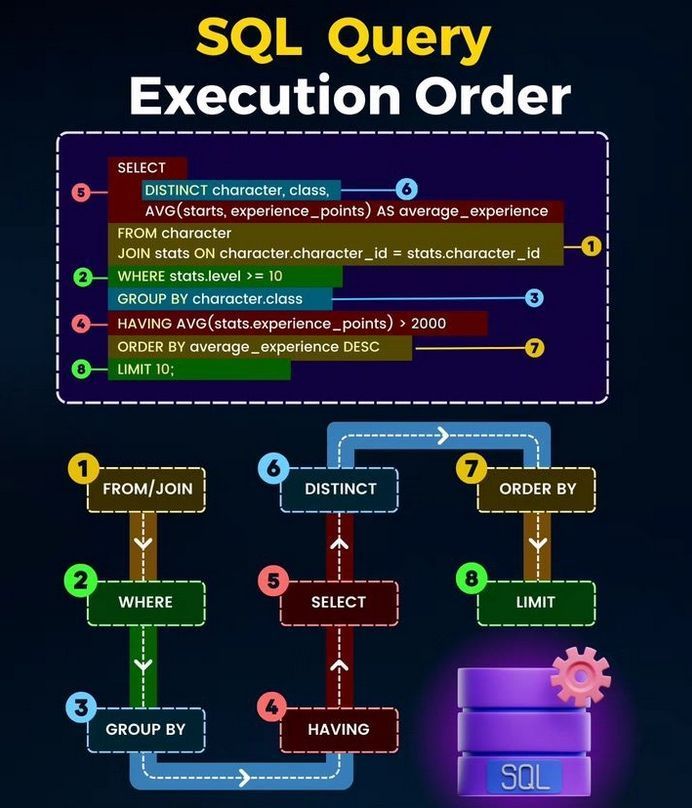When you write an SQL query, the database engine executes the clauses in a specific order, which is different from the sequence in which you write them.
Understanding this order is crucial for optimizing queries and debugging issues efficiently. Here’s a concise guide to the SQL query execution order:
1. 𝗙𝗥𝗢𝗠 𝗮𝗻𝗱 𝗝𝗢𝗜𝗡
Purpose: Identify and join tables.
FROM: Specifies the tables to be queried.
JOIN: Combines records from related tables.
Example:
“FROM Employees
JOIN Departments ON Employees.DeptID = Departments.DeptID
“
2. 𝗪𝗛𝗘𝗥𝗘
Purpose: Filter rows based on conditions.
Filters individual rows that meet the specified criteria.
Example:
“WHERE Employees.Salary > 50000
“
3. 𝗚𝗥𝗢𝗨𝗣 𝗕𝗬
Purpose: Group rows based on column values.
Creates summary rows using aggregate functions.
Example:
“GROUP BY Departments.DeptName
“
4. 𝗛𝗔𝗩𝗜𝗡𝗚
Purpose: Filter groups based on conditions.
Filters groups created by GROUP BY.
Example:
“HAVING COUNT(Employees.EmployeeID) > 5
“
5. 𝗦𝗘𝗟𝗘𝗖𝗧
Purpose: Select columns for the final result.
Specifies which columns to display.
Example:
“SELECT Departments.DeptName, COUNT(Employees.EmployeeID) AS NumEmployees
“
6. 𝗗𝗜𝗦𝗧𝗜𝗡𝗖𝗧
Purpose: Remove duplicate rows.
Ensures uniqueness in the result set.
Example:
“SELECT DISTINCT Employees.JobTitle
“
7. 𝗢𝗥𝗗𝗘𝗥 𝗕𝗬
Purpose: Sort the result set.
Orders the rows based on specified columns.
Example:
“ORDER BY NumEmployees DESC
“
8. 𝗟𝗜𝗠𝗜𝗧 / 𝗢𝗙𝗙𝗦𝗘𝗧
Purpose: Limit the number of rows returned.
Constrains the result set.
Example:
“LIMIT 10 OFFSET 20
“
Complete Example Query
Here’s how it looks when put together:
“SELECT Departments.DeptName, COUNT(Employees.EmployeeID) AS NumEmployees
FROM Employees
JOIN Departments ON Employees.DeptID = Departments.DeptID
WHERE Employees.Salary > 50000
GROUP BY Departments.DeptName
HAVING COUNT(Employees.EmployeeID) > 5
ORDER BY NumEmployees DESC
LIMIT 10 OFFSET 20
“
